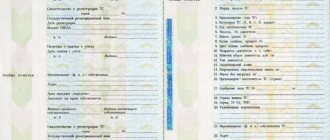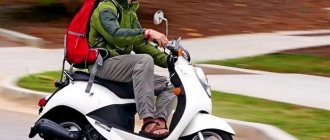This article will discuss which group of vehicles is open to the driver if he has a category C driving license, what subcategories of these rights exist and what features they have.
Let's talk about why category “C” is needed, what vehicles (TS) can be driven with it, and what needs to be done to open the rights of this category.
What cars can be driven with category “C”
An open C-category on a driver's license gives the right to drive freight vehicles weighing more than 3.5 tons. These are primarily vans and medium-sized trucks. The exception is passenger transport, which requires category “D” to drive.
For reference! Category “C” does not include buses with passenger vans, trucks up to 3.5 tons, and passenger vehicles.
If a trailer is attached to the car, then, according to the rules, its weight should not exceed 750 kg.
The demand for drivers whose professional activities require a category C driving license is constantly growing. Among the professions where this category is required are truck drivers, truck crane drivers, forklifts, freight forwarders, carriers, etc. The work of these specialists is well paid for the reason that driving this type of transport is very difficult and requires certain skills.
Category “C” can be divided into 3 subcategories: CE, C1, C1E.
The only way they differ from each other is the maximum weight of the vehicle (+ trailer), which corresponds to this subcategory.
Subcategory CE
This subcategory is optional. It is necessary to have it to drive a C-category vehicle with a trailer (semi-trailer) weighing over 750 kg.
Subcategory C1
Subcategory C1 gives the right to drive medium-sized trucks weighing from 3.5 to 7.5 tons. If necessary, it is allowed to hook up a light trailer up to 750 kg.
If the driver has opened category “C”, then he can safely drive a vehicle of subcategory C1. This is not against the law.
Subcategory C1E
This is also an additional subcategory, after opening which the driver has the right to get behind the wheel of a category C1 truck with a heavy trailer (over 750 kg), the total weight of which does not exceed 12 tons.
To obtain subcategories CE and C1E, additional training is required, after which you will have to pass an exam at the traffic police. Persons aged 21 years and older who have driving experience and experience driving category C or C1 cars for 1 year or more are allowed to take part in the training.
For your information! Drivers with an open category “C” are allowed to service vehicles that require a subcategory “C1” to drive. Similarly with subcategories CE and C1E: if CE is open, then the driver has the right to drive vehicles of the CE1 subcategory.
Driver's license
Many students in driving schools ask the question: “what category of rights is required for permission to drive a truck?” The answer is clause “E” in the license, which guarantees the operation of freight transport with a semi-trailer. To obtain the appropriate document you need: a health certificate and at least one year of truck driving experience.
To obtain the “CE” category, you do not need repeated theoretical training; you must precisely perform the following driving elements:
- drive a car in reverse;
- install the trailer for unloading to the overpass.
If the driving test results are positive, the driver receives permission to drive a truck.
Driver's license with open categories.
Categories for truckers
To drive a truck, no special education is required: you have received a certificate, paid for training at a driving school for a license to drive cars and trucks, passed the traffic police exam and practice - the coveted certificate in your hands.
Next, you need one year of truck driving experience. To do this, you need to work, for example, on a Gazelle, ensuring the delivery of goods within the city or in the immediate vicinity. Then you apply for category “E” (for which you need a document on completion of a driving school) and complete two practical driving options without errors.
Then you need to work for another two years as a driver of a truck with a trailer and apply to a fleet that specializes in long-distance transportation.
How to get a license
Any Russian citizen who has reached the age of 16 can obtain a driver's license allowing him to drive a car. For training, driving schools have been built in cities, where those who wish, after passing exams and practical driving, receive a driver's license of the established form.
For your information! Plastic cards are issued only after mandatory verification of acquired knowledge of traffic rules.
Permitted vehicle weight for category “C”
List of subcategories and the vehicle mass corresponding to each subcategory, the maximum permitted by the rules:
- C - medium and heavy freight transport 3.5 tons and above + trailer weighing not more than 750 kg;
- C1 - small, medium freight transport weighing 3.5-7.5 tons + trailer up to 750 kg;
- CE - trucks corresponding to C-category + trailer weighing over 750 kg;
- C1E - freight transport corresponding to subcategory C1+ trailer weighing over 750 kg.
There is a significant difference between subcategories CE and C1E. In subcategory C1E, the weight of the vehicle without load must be greater than the weight of the trailer, and their total weight must not exceed 12 tons. The CE category has no such restrictions.
Category “D” – bus
Category “D” includes vehicles with eight or more passenger seats (type of vehicle – any). In this case, to train and obtain a category “D” license, the driver must be 21 years old and have a “C” category. After opening category “D”, the driver can drive any type of bus. The exception is “accordion” buses: the category does not apply to them. In addition, you cannot drive a bus with a heavy trailer (more than 750 kg). Category "DE" required.
How to get a category “C” license
Before obtaining a license for category “C”, you must complete training for 4-6 months. at a driving school and pass exams. You can start studying at the age of 17. But you can take driving tests only from the age of 18.
You should always choose a driving school, paying attention to its technical equipment, the availability of teaching aids, and the level of professionalism of the teachers. It is necessary to familiarize yourself with the package of services that are included in the cost of the full course of training and listen to the recommendations of friends who have graduated from this driving school.
Driving lessons
In many regions of Russia, driving schools train truck drivers, so applicants who have passed a medical selection and successfully passed the exam for driving a large vehicle can obtain a truck license.
Some similar organizations provide free training with subsequent mandatory employment, for example, the Moscow company X5 Logistics.
Training program
The approved training includes the following subjects:
- practical skills in driving trucks;
- features of maneuvers on a narrow road;
- specific driving techniques;
- performing parking;
- feeding for unloading at different angles.
For your information! A truck driver who delivers goods over long distances is a prestigious and well-paid profession, but it is not suitable for every person.
Detailed information is visible in the video:
Exams
After completing the study of the theoretical foundations of the future profession, examinations for knowledge of traffic rules begin.
Those who answer the questions correctly are allowed to practice driving, which consists of the following stages:
- driving a truck over the rough terrain of the circuit;
- passing through individual sections - approaching an overpass, winding traffic or “snake”, parking.
After successful maneuvering around the racetrack, the final part begins - a ride with an instructor on a tractor-trailer along the city streets. Positive grades in exams and practice guarantee that subjects will receive an “EC” category truck driving license.
Exam for opening category E.
What is important for a driver to know
To avoid accidents on the roads, when driving a large vehicle you need to know the following nuances:
- eliminate sudden steering movements;
- the braking distance increases for a loaded truck;
- the tractor is constantly affected by inertia from the weight of the semi-trailer;
- when cornering, the trailer may skid;
- you need to reduce speed before maneuvering, for example, when entering turns;
- When driving, the driver must take into account the dimensions of the vehicle.
Every truck driver is required to know the material parts of the car, be able to fix minor breakdowns and fill out transport invoices for the transported cargo.
Important! For truck driver applicants, you must have at least 3 years of truck driving experience, otherwise you will be driving as a trainee for six months with a salary lower than that of your mentor.
Price
There are no exams before enrolling in a driving school, but training is paid. To get two categories at once, for example, “C” and “E,” you will have to spend 25–45 thousand rubles from the family budget. After completing their training, driving school graduates take exams on a computer at the State Traffic Safety Inspectorate.
Passing testing to open categories.
How to open category “C” if there is “B”
Those people who want to learn how to drive a truck weighing over 3.5 tons can be aimed at obtaining a driver’s license with category “C”. These are dump trucks, pickups, vans, etc. Therefore, drivers who have long acquired category “B” often ask how to open category “C”. Anyone wishing to receive category “C” should understand what the difference is between the two categories “B and C”.
What is the difference between categories B and C?
A person who takes all the steps to open category C for driving cannot do without special skills. And at this stage he is faced with a very difficult task. A truck differs from a car in its dimensions and weight. Large mass affects inertia, making it more difficult to control the car. Maneuvers such as accelerating and stopping a car require a lot of effort. Due to its large dimensions, the car is extremely dangerous on the roads, especially at the moment when it makes difficult maneuvers.
Subtleties of opening category C
Before you get category C if you have B, you need to know that you cannot do without training and certification. But when passing the theoretical exam, there is a small trick: if you just recently opened category D and passed the theoretical exam, then you will not have to take it again. The thing is that the certification results are stored for 3 months. from the moment of passing the exam.
Opening category C with existing B
This training has some differences from the primary one, where the future motorist is trained from the very basics.
It will be enough for the holder of a category B license to attend retraining courses. Once they are passed, the car enthusiast will need to pass the exam, which takes place in 3 stages.
Before you start taking the exam to open category C, you need to prepare for the exam papers. This will help you pass the exam in its theoretical part. Immediately before the exam, you should take care of purchasing a medical certificate, prepare a passport and pay the state fee.
What you need to know when driving a truck
When driving trucks, there are a large number of nuances that should be taken into account in order to avoid unpleasant situations:
- sudden movements of the steering wheel should be avoided;
- increased braking distance;
- action of inertial force;
- the occurrence of drifts and drifts when cornering;
- early reduction in speed;
- taking into account the dimensions of the car.
How to properly back up a truck with a semi-trailer
Transportation of goods as the main profession requires the driver to have a category “C” license, and in some cases, category “E”, minor repair skills and knowledge of the technical structure of cars, traffic rules, legislation regulating the transportation of various cargoes, and the ability to fill transport documentation.
How to get category “C”: step-by-step instructions
If you don’t know how to get category C, we have developed a sequence of actions that will help you achieve your goal:
- Always take classes responsibly, don’t miss lectures without reason, take notes on the material, and don’t hesitate to ask questions if you don’t understand something. The teacher always pays attention to the features of driving a particular vehicle, remember what he says. Take notes especially when it comes to the nuances of traffic rules.
- Don't forget to undergo a medical examination before the exam. Before visiting the required specialists, you must pay for their services. Once you receive an opinion from each doctor individually, an overall verdict regarding the state of your health will be made. If you take category “C”, you will face increased requirements, because you have hard and very responsible work ahead of you, in which your health should not fail. To work in this category, strong and tall men are always required. If the height of a potential driver does not exceed 150 cm, he will be denied a certificate.
- Carefully study all tickets taken from exam publications. Learn to clearly understand what the task requires of you; if possible, remember the answers just in case.
- Try to successfully pass the theoretical exam at a driving school.
- Don’t neglect practical classes; use the services of an instructor when traveling to the city. He will tell you about all the nuances of moving in urban conditions, how traffic rules are applied in practice.
- If you are confident in your abilities and refuse additional classes, then do not waste your time and get ready to take the practical driving test at a driving school.
- During the practical certification, you will have to show your driving skills, first on the driving school's circuit, and then within the city. This will take into account how correctly you apply your knowledge of traffic rules in urban conditions.
- If you fail the internal exam, you will have to take several additional lessons and only then apply to retake the practical certification.
As soon as you pass the exam at the driving school, you can move on to the next stage and repeat your success when passing the exam at the traffic police.
Subcategory “D1E” - buses of category “D1” with a heavy trailer
This subcategory allows driving buses of subcategory “D1” with a heavy trailer weighing more than 750 kg. Here (as with the “C1E” subcategory), the car must weigh more than the trailer, and their total weight must not exceed 12,000 kg. In this case, the trailer should not be intended for transporting passengers (in this case, category “DE” will be required). The presence of the “DE” category automatically gives the right to drive a vehicle of the “D1E” subcategory.
Sometimes choosing the right category or subcategory of a driver’s license on your own can be quite problematic (an example with minibuses was already given above). If there are any doubts about whether a vehicle belongs to any category or subcategory, you can find information in the vehicle registration certificate.
We remind you that in Moscow only traffic police representatives come to the Central Driving School to take a practical exam. Our native walls help us!
How to pass the Category C exam
Before taking the exam at the traffic police, you need to collect a package of necessary documents and pay the state fee.
The theoretical part, consisting of 20 questions, is always taken first. The exam is considered valid if the examinee answers 18 out of 20 questions. It turns out that you can only make 2 mistakes, otherwise you will have to study again and retake the exam.
The theoretical exam is immediately followed by a practical exam, where driving skills are tested on the site. Here you need to show all your skills in driving trucks, including the ability to start, stop on a steep slope, and then start moving again, parallel park, turn 90 degrees, make a snake, turn around correctly, and drive into a pit. If this distance is completed, then you will be allowed to take the road test in the city.
Credit will be received only if the examinee does not violate traffic rules.
And please note that driving in first speed around the city does not count; you need to show your ability to move in second and third speeds.
If the exam is not passed: is it possible to retake it?
Of course, you are allowed to retake the exam, but there are specific deadlines. As for the theory, you can retake it in a week. And so every time after the next failure, because... The number of attempts has no restrictions.
A completely different attitude develops towards retaking practical driving:
- in a week you can make your first attempt to retake the exam;
- there can be exactly 3 such attempts every 7 days, then measures are tightened, and each attempt can be demonstrated once a month;
- if within 6 months. the driver will not pass the practical driving test, he will be sent to retake the theoretical exam.
You failed to pass the exam to obtain category C the first time, you have a second attempt in 7 days. This means you are given time to prepare. Review all the tickets again and work through them thoroughly, especially those that you do not know very well. Take additional driving lessons.
Driving school exams
A person who wants to become a professional truck driver needs to undergo appropriate training at a driving school. After completing the theoretical stage of training, it is time to take an exam on knowledge of the rules of the road. If the test is successfully passed, the future truck driver proceeds to the practical part of the exam, which consists of the following stages:
- driving a truck on a closed circuit;
- passing various obstacles - overpass, “snake”, parking.
If you successfully complete the tasks of the autodrome, the final stage of the exam begins - a trip in a truck around the city. Upon successful completion of all tests, the person receives a driver's license.
Driving a truck like a snake
What documents should a driver with category “C” carry with him?
When driving a truck, the driver must always have the following documents with him:
- driver's license;
- registration certificate;
- insurance in the form of a compulsory motor liability insurance policy;
- a power of attorney issued by the owner of the vehicle in the name of the driver, if he himself is not the owner of this car;
- If the car is loaded, then there must be accompanying documents for the cargo. Therefore, without a waybill, cargo declaration, license or delivery agreement, the driver has no right to move;
- To transport dangerous goods, you must have a certificate confirming that the driver has undergone special training.
Subcategory “D1” - bus with a number of passenger seats from 8 to 16
Subcategory “D1” includes vehicles with a number of passenger seats from 8 to 16. License to drive buses – category “D” provides the ability to drive a vehicle of subcategory “D1”. The bus can operate a light trailer up to 750 kg.
Important!
A subcategory “D1” license allows you to drive passenger minibuses. At the same time, there are foreign minibuses with more than 16 seats for passengers. To operate them, category “D” is required.
How to get a category A and A1 license for a motorcycle in 2020?
According to Russian laws, any driver driving on the roads must have an appropriate license. And it doesn’t matter how many wheels your vehicle has - four or just two. Relatively recently, the requirements for motorcycle and scooter drivers were more flexible. Since 2013, the situation has changed radically and even a scooter driver is required to undergo training at a motorcycle school.
Motorcycle license: is it possible to do without them?
The law is adamant. If you are not going to sit behind the wheel of a bicycle forever, but plan to at least occasionally get behind the wheel of at least a moped, a license is required. And this is not a whim of traffic police inspectors and motorcycle schools who want to “extract” more money from you.
A qualified driver who has undergone training clearly knows how to behave in a given traffic situation. While the “disenfranchised” driver only guesses about the correctness of his behavior on the road. And it’s good if such driving only ends with a fine and confiscation of the two-wheeled horse.
Don’t even hope that the weak engine of your scooter will be a mitigating circumstance when meeting with traffic police officers. No one has canceled age restrictions either.
But owners of motocross motorcycles can breathe easy. They do not face fines or confiscation of the vehicle for driving without a license. But as long as they remain on the territory of sports tracks.
The reason for the “indulgence” is simple: a motocross motorcycle belongs to the category of sports equipment. And as long as its owner races on dirt tracks, he does not break any rules.
At what age can you drive a motorcycle?
This parameter is directly related to the type of two-wheeled vehicle that the driver plans to drive. There are motorcycles that you can drive no earlier than 18 years old. But there are categories of vehicles available for driving from the age of 16.
| Scooters, mopeds | Engine capacity not exceeding 50 cubic meters | From 16 years old |
| Light motorcycles | Engine capacity up to 125 cc | From 16 years old |
| Motorcycles | Engine capacity is more than 125 cubic meters | From 18 years old |
| Tricycles, ATVs | Engine capacity from 50 cubic meters | From 18 years old |
You are allowed to start learning how to operate a motorcycle long before your 18th birthday. But be patient, you will be allowed to take the exams only when you reach this age.
What categories of motorcycle licenses are there in 2021?
The motor market is ready to offer a huge selection of motorcycles. How not to get confused in this diversity and understand which category is needed to control a particular two-wheeled horse? The classification decided everything.
Since motorcycles are different, it was decided to distinguish three categories: “M”, “A”, “A1”. Each of them makes it possible to control motorcycles with different weights and engine sizes.
| Category “M” Appeared in 2013 | Engine capacity not exceeding 50 cubic meters | Mopeds (tricycles, scooters); quads; mokiki; scooters |
| Category “A1” (most common among teenagers) | engine capacity from 50 to 125 cubic meters; maximum power – up to 11 kW. | Light motorcycles |
| Category "A" | engine capacity up to 125 cubic meters; vehicle weight in running order up to 400 kg | Motorcycles |
If the future driver has already crossed the 18-year mark, it makes sense to study for category “A”. In this case, “M” and “A1” will be given to him as bonuses. The significant date is far away, but you really want to drive, choose “M” or “A1” - depending on your vehicle.
License for a motorcycle with a sidecar
Are you planning to buy a motorcycle with a sidecar? Hurry up to get your category “A” license. For your own safety, do not be lazy to take a couple of lessons on riding such a motorcycle.
This type of transport is fundamentally different from its two-wheeled counterpart. Because of the stroller on one side, it takes up much more space on the road. And this requires a special habit.
Moped and scooter licenses
The emergence of the “M” category has made life easier for owners of scooters and mopeds. Having reached 16 years of age, complete training at a motorcycle school and freely ride lightweight vehicles.
If the driver has been trained for category “A”, then “M” is entered automatically. What gives you the right to drive a light scooter.
Driver requirements
- The future driver must be healthy; the appropriate certificate is obtained before the start of the training course. It would be a shame to take a course at a motorcycle school and find yourself unfit for health.
When undergoing a medical examination, warn the medical commission about your desire to open the “M” category.
If you do not do this, the category will not appear in your rights. You will not be able to drive a moped.
- Reaching a certain age – each category has age parameters;
- Completion of training at a motorcycle school corresponding to the required category.
Obtaining rights: specifics
To obtain a motorcycle license, you do not have to take the traditional city exam for obtaining any other license. In the case of a motorcycle, traffic police inspectors are limited to checking theoretical knowledge of traffic rules. Testing of practical skills takes place in special training grounds and sites.
Until the newly minted motorcyclist passes the theoretical course, he will not be allowed to take practical tests. In case of failure, retaking the theory is allowed after 2 weeks.
Some schools refuse to enroll in motorcycle riding courses in the winter. This is due to the complexity of road conditions. It is difficult to teach an inexperienced driver all the subtleties of driving on slippery roads.
Documents of the future driver
Until the applicant submits a full package of documents, he simply will not be allowed to study.
- Copy of the passport.
- Certificate with a conclusion from the medical board.
- 2 photos 3x4.
- Statement.
- A document confirming the fact of successful training in a motorcycle school.
- Payment for payment of state duty.
- Consent from parents - if the future motorcyclist is under 18 years of age.
Procedure for obtaining a driver's license
This procedure also has its own course of events.
- Checking the authenticity of each piece of paper - rest assured, the chance with false documents will definitely not work here;
- The applicant for a license receives access to testing;
- The first stage of exams is theory;
- The second stage is practice at a special training ground;
- Obtaining a driver's license.
Passing exams: step by step
The exam is divided into two independent blocks: theoretical and practical. The first involves testing the theoretical framework and rules. The second is aimed at identifying practical skills and abilities.
The theoretical part is taken entirely computer-based. During the test for knowledge of traffic rules, the test taker answers 20 questions. Ideally, the number of errors is zero.
20 minutes of time are allotted for the test - one minute per question. If one mistake is made, another 5 minutes are added to the time. During these minutes you need to answer an additional 5 questions from the block where the mistake was made.
If you make mistakes on 2 questions, 10 minutes and 10 questions are added to the time. If you miss 3 questions, the examinee is sent to retake.
The practical side of the exam takes place in the fresh air - at the training ground. Here everything is like at school, for a mistake - a minus to the final mark. It is enough to score 4 penalty points to be considered for a retake.
Minus 1 point for:
- a warning signal not given by hand about planned braking;
- late braking before the stop line;
- low beam lights not turned on.











